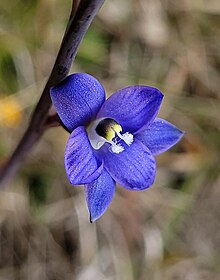| Wyong sun orchid | |
|---|---|

| |
| Near Warnervale | |
| Conservation status | |
 Critically endangered (EPBC Act) | |
| Scientific classification | |
| Kingdom: | Plantae |
| Clade: | Tracheophytes |
| Clade: | Angiosperms |
| Clade: | Monocots |
| Order: | Asparagales |
| Family: | Orchidaceae |
| Subfamily: | Orchidoideae |
| Tribe: | Diurideae |
| Genus: | Thelymitra |
| Species: | T. adorata |
| Binomial name | |
| Thelymitra adorata Jeanes | |
Thelymitra adorata, commonly called the Wyong sun orchid or praying sun orchid, is a species of orchid that is endemic to a very small area of New South Wales. It has a single relatively large, erect, fleshy, channelled leaf and up to thirteen deep blue, self-pollinating flowers.
Description
Thelymitra adorata is a tuberous, perennial herb with a single erect, dark green, fleshy, channelled, linear leaf 140–400 mm (6–20 in) long and 5–20 mm (0.2–0.8 in) wide with a purplish base. Up to eighteen deep blue flowers 14–22 mm (0.6–0.9 in) wide are arranged on a flowering stem 250–650 mm (10–30 in) tall. The sepals and petals are 6–12 mm (0.2–0.5 in) long, 3–6.5 mm (0.1–0.3 in) wide and light brown on their reverse side. The column is pink or purplish, 4.5–6.5 mm (0.18–0.26 in) long and 2.5–4 mm (0.1–0.2 in) wide. The lobe on the top of the anther is dark brown to blackish with a yellow tip, tubular and sharply curved with a notched tip. The side lobes curve upwards and have untidy, mop-like tufts of white hairs. Flowering occurs from September to November but the flowers are self-pollinating and only open on sunny days.
Taxonomy and naming
Thelymitra adorata was first formally described in 2011 by Jeff Jeanes and the description was published in Muelleria from a specimen collected near Wadalba. The specific epithet (adorata) is a Latin word meaning "honor", "esteem" or "worship", referring to the column which, in side view, "has been likened to a person in prayer".
Distribution and habitat
The Wyong sun orchid usually grows in grassy woodland in very small isolated colonies between Wyong, Warnervale and Wyongah.
Conservation
Thelymitra adorata only occurs in a small number of isolated sites and is threatened by weed invasion, habitat fragmentation and disturbance, and inappropriate management activities. It is listed as "critically endangered" under the Environment Protection and Biodiversity Conservation Act 1999 (EPBC Act), and the Biodiversity Conservation Act 2016. In 2023, a proposal to develop land which included a significant portion of T. adorata habitat and would have resulted in the loss of approximately 500 plants was denied under the EPBC Act.
References
- "Thelymitra adorata". Australian Plant Census. Retrieved 8 May 2024.
- ^ "Conservation advice - Thelymitra adorata" (PDF). Australian Government Department of the Environment. Retrieved 23 May 2018.
- ^ Jones, David L. (2006). A complete guide to native orchids of Australia including the island territories. Frenchs Forest, N.S.W.: New Holland. p. 238. ISBN 1877069124.
- ^ Jeanes, Jeffrey A. (2011). "Resolution of the Thelymitra aristata (Orchidaceae) complex of south-eastern Australia" (PDF). Muelleria. 29: 122–123. Retrieved 21 May 2018.
- "Thelymitra adorata". APNI. Retrieved 9 May 2024.
- Brown, Roland Wilbur (1956). The Composition of Scientific Words. Washington, D.C.: Smithsonian Institution Press. p. 418.
- ^ "Thelymitra sp. 'Adorata' - critically endangered species listing". New South Wales Government Office of Environment and Heritage. Retrieved 23 May 2018.
- ^ "Wyong sun orchid - profile". New South Wales Government Office of Environment and Heritage. Retrieved 23 May 2018.
- "Referral summary· EPBC Act Public Portal". Retrieved 2024-01-17.
| Taxon identifiers | |
|---|---|
| Thelymitra adorata | |